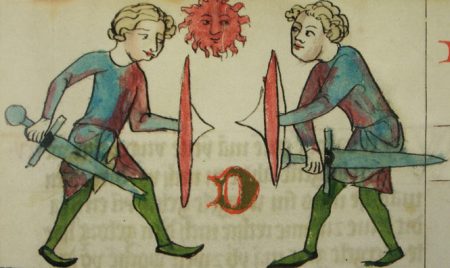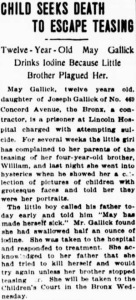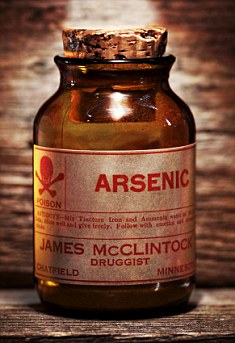Source: The Evening World (New York City), November 30th 1914. Content on this page is © Alpha History 2019-23. Content may not be republished without our express permission. For more information please refer to our Terms of Use or contact Alpha History.
Category Archives: Crime
1786: Danish murderer uses sneaky arsenic method
According to Mangor, the farmer had gone through three young wives in the space of a few years. Each wife had been in good health but died within a day or two of contracting similar symptoms. The farmer’s own behaviour also aroused local suspicions. Six weeks after the death of his first wife he married a servant girl – but she lasted but a few years before falling victim to the mystery ailment, allowing the farmer to marry yet another maidservant.
Eventually, in 1786, wife number three died from the same malady:
“About three in the afternoon, while enjoying good health, she was suddenly seized with shivering and heat in the vagina… Means were resorted to for saving her life but in vain: she was attacked with acute pain in the stomach and incessant vomiting, then became delirious, and died in 21 hours.”
“Grains of arsenic were found in the vagina, although frequent lotions had been used in the treatment. The labia were swollen and red, the vagina gaping and flaccid, the os uteri gangrenous, the duodenum inflamed, the stomach natural.”
The farmer was arrested and placed on trial. To prepare for his testimony Dr Mangor conducted a number of experiments on cows. “The results clearly showed that when applied to the vagina of these animals”, he wrote, “it produces violent local inflammation and fatal constitutional derangement”.
The farmer, as might be expected, was found guilty. His punishment is unrecorded but it seems likely he was executed. The number of cows to die in the name of vaginal-arsenic justice is also not recorded.
Source: Dr C. Mangor, “The history of a woman poisoned by a singular method” in Transactions of the Royal Society of Copenhagen, v.3, 1787; Sir Robert Christison, A Treatise on Poisons &c., London, 1832. Content on this page is © Alpha History 2019-23. Content may not be republished without our express permission. For more information please refer to our Terms of Use or contact Alpha History.
1722: Man murders rival by “breaking the muscles” of his yard

In 1723 the mayor of Tenby, Thomas Athoe, along with his son, also named Thomas, were apprehended and charged with murdering George Merchant. According to trial records, the two parties had quarreled over the sale of some cattle. The Athoes also bore a grudge against George Merchant, who had “married a sweetheart of young Athoe’s”.
Seeking revenge, the Athoes tracked Merchant and his brother, Thomas, to a place called Holloway’s Water. Using “great sticks”, the Athoes knocked the Merchants from their horses and beat them viciously. They then fell into a frenzy of genital grabbing, George Merchant coming off the worst:
“Taking fast hold of [Thomas Merchant’s] privities, [Athoe Senior] pulled and squeezed him to such a violent degree that had he continued so doing a few minutes longer, it had been impossible for the poor man to have survived it. The pain he suffered is past expression, and yet it fell short of what his brother endured. Young Athoe… seized him by the privy members and, his yard being extended, be broke the muscles of it, and tore out one of his testicles, and calling to his father said ‘Now I have done George Merchant’s business!’ This horrible action occasioned a vast effusion of blood.”
As George Merchant lay dying, Athoe Junior caught hold of “the deceased’s nose with his teeth [and] bit it quite off”. Surgeons who examined Merchant’s body post mortem suggested that his wounds were “sufficient to have killed six or seven men”. The Athoes claimed to have acted in self defence after been attacked by the Merchants, however they produced no evidence of an assault.
The Athoes were found guilty and transported to London. In July 1723, they were dispatched from a ‘hanging tree’ on the Canterbury Road, near what is now Walworth.
Source: Select Trials for Murders, Robberies, &c., Vol. 1, December 1720-October 1723. Content on this page is © Alpha History 2019-23. Content may not be republished without our express permission. For more information please refer to our Terms of Use or contact Alpha History.
1456: Trial by combat ends with penis biting, eye gouging

In 1456, a Hampshire man named Thomas Whytehorne was found hiding in the New Forest, arrested and convicted of several charges of theft. To spare himself from execution, Whytehorne agreed to provide the authorities with names of his accomplices, as well as other local criminals. He also offered to stand combat against anyone who disputed his accusations.
Whytehorne was a large and powerful man so there were no takers – until he informed against a local boatman named James Fyscher. A devoutly religious man, Fyscher did not take kindly to being falsely accused of a crime, so invoked his right to trial by combat.
The local lord agreed to Fyscher’s request and handed down a set of regulations for his combat with Whytehorne:
“[Both] must be clothed all in white sheep’s leather… They should have in their hands two staves of green ash, of three foot in length… and on the other end a horn of iron, made in the shape of a ram’s horn, the small end as sharp as might be made… If their main weapon is broken they must fight with their hands, fists, nails, teeth, feet and legs… They should make their foul battle upon the most sorry and wretched land that can be found about the town… They both must be fasting… and if they need any drink, they must take their own piss.”
The trial by combat took place in Winchester. Public opinion was firmly against Whytehorne, a career criminal with a reputation for dishonesty. Regardless, Whytehorne’s strength won him an early advantage after he managed to break Fyscher’s weapon. The magistrate stopped the trial and disarmed both men, leaving them to fight ‘tooth and nail’.
“They did fight with both their teeth, such as the leather of their clothing and their flesh was torn on many parts of their bodies. And then the false accuser [Whytehorne] cast the innocent [Fyscher] down upon the ground, and did bite his private member, causing the innocent to cry out. And then with a new strength, the innocent recovered to his knees that took the false accuser’s nose with his teeth and put a thumb into his eye, that the appellant cried out and prayed for mercy, admitting that he had accused falsely against him [Fyscher] and 18 other men.”
According to a contemporary chronicler, Whytehorne was immediately hanged for making false accusations. Fyscher was cleared and released, though he was by now severely wounded. The only thing said of Fyscher’s fate was that he “went home, become a hermit and within a short time died”.
Source: Gregory’s Chronicle, 1451-60. Cited in James Gairdner (ed.), A Citizen of London in the 15th Century, 1876. Content on this page is © Alpha History 2019-23. Content may not be republished without our express permission. For more information please refer to our Terms of Use or contact Alpha History.
1322: Urine spill leads to fatal assault in London
“William… stood at the top of St Vedast lane, near Chepe, and made water into a certain urinal [but] he cast the urine into the shoe of [Philip] and, because the latter complained, the said William struck him with his fist…”
According to a coronial report, William picked up a baton dropped by Philip and:
“…feloniously struck the said Philip over the forehead, inflicting a mortal wound an inch long and penetrating to the brain so that he fell to the ground, and was thence carried by men unknown for charity’s sake to the said hospital where he had his ecclesiastical rights… He died at the third hour of the said wound.”
Three bystanders escorted William off to prison but his subsequent fate is not recorded.
Source: Calendar of Coroners Rolls for the City of London, 1300-1378, roll B43. Content on this page is © Alpha History 2019-23. Content may not be republished without our express permission. For more information please refer to our Terms of Use or contact Alpha History.
1860: Woman charged with ant infanticide
According to the police brief, witnesses observed Sadler entering a paddock on the morning of January 18th and leaving it that afternoon, reportedly in a weak and distressed state. This information was communicated to the local constable, who the following day carried out an inspection of the paddock.
In the field he found a newborn baby, naked on the ground under a tree and atop a nest of large ants. The child, whose gender was not recorded, was unconscious and covered “head to toe” with ants. It briefly regained consciousness while being bathed but expired later that afternoon:
“We had an opportunity of examining the body of the deceased infant and it presented one of the most affecting spectacles we ever beheld. It had every appearance of being not only a healthy but an extraordinarily strong child, perfect in symmetry and strong of limb. The whole side of its right thigh and foreleg, the foreleg of the left leg, its right side, its face and forehead and the right ear were perforated with holes eaten by the ants.”
A doctor examined Sadler and her home and testified that a birth had likely taken place. Another witness swore he saw the defendant acting “like a madwoman” on the date in question. The trial judge instructed jury members to return a guilty verdict only if they could be certain of the defendant’s sanity.
Unable to do so, the jury found her not guilty of murder. Sadler’s subsequent fate is not recorded.
Sources: Illawarra Mercury (Wollongong) February 17th 1860; North Wales Chronicle, April 21st 1860. Content on this page is © Alpha History 2019-23. Content may not be republished without our express permission. For more information please refer to our Terms of Use or contact Alpha History.
1835: Madman tries to kill the French king – with 20 guns at once

In July 1835, assassins targeted the French king, Louis-Philippe, as he reviewed troops in Paris. News of the attempt on the king’s life was conveyed by telegram to the French ambassador:
“An atrocious act was attempted this morning during the review [of troops]. The King of the French was not touched, although his horse was killed. None of the Princes were wounded. The Duke of Treviso was killed. Several guards, aides-de-camp and National Guardsmen were killed or wounded. The deed was committed by means of an infernal machine placed behind a window… Paris is quiet and indignant.”
The leader of this bizarre assassination attempt was Giuseppe Marco Fieschi. A former soldier and serial thief, Fieschi served several years’ hard labour in his native Corsica before escaping to Paris.
Once in the capital, Fieschi took up with political radicals and began to plot the king’s murder. But unlike John Wilkes Booth and Lee Harvey Oswald, Fieschi and his accomplices left nothing to chance. They designed and constructed their “infernal machine”: a battery of 20 muskets attached to a wooden frame, all rigged to fire simultaneously.
The machine was aimed at the royal party from an elevated window overlooking the Boulevard du Temple. The firing of the “infernal machine” proved devastating: it killed 18 soldiers, including a marshal and former prime minister. Louis-Philippe and other royals were not seriously injured, however, one shot grazed the king’s temple and another struck his horse.
The backfiring from the “infernal machine” also took its toll on Fieschi, who was hit in the head with shrapnel and badly burned. He was quickly captured and given medical attention, then put on trial for attempted regicide. Fieschi and two of his accomplices were guillotined in February 1836.
Source: Telegram to the French ambassador in London, July 28th 1835. Content on this page is © Alpha History 2019-23. Content may not be republished without our express permission. For more information please refer to our Terms of Use or contact Alpha History.
1565: Abused mule has feet cut off, then burned alive
The farmer was put on trial, convicted of buggery and bestiality and sentenced to be burned alive. The mule, despite its passive role, was sentenced to the same fate. But according to Ranchin, the mule refused to go without a fight and turned nasty, prompting brutal action from the executioner:
“Mulus… erat vitiosus et calcitrosus. In primis abcissi fuere quatuor pedes ipsius et demun in ignem projectus et una cum homine combustus fuit.”
(‘The mule was vicious and kicking. He was dealt with first, all four of his feet were removed and cast into the fire, after which he and the man burned.’)
Source: Memoires des Antiquaires de France, v.8. Content on this page is © Alpha History 2019-23. Content may not be republished without our express permission. For more information please refer to our Terms of Use or contact Alpha History.
1989: Man escapes electric chair, dies on electric toilet
Sloan went on trial in 1981, was convicted of murder and sexual assault and sentenced to die in South Carolina’s electric chair. Sloan’s death sentence was commuted to life imprisonment in 1983 after a retrial cleared him of the sexual assault. But as fate would have it, Sloan was still destined to die on an electric chair, albeit a different one:
“Convicted murderer Michael Anderson Godwin… has died after electrocuting himself, authorities said. Godwin was seated on a metal toilet and was apparently trying to repair earphones to a television set, when he bit into the electrical cord, said State Corrections spokesman Francis Archibald.
‘It was a strange accident’, Archibald said. ‘He was sitting naked on a metal commode’… Richland County Coroner Frank Barron said Godwin was severely burned in his mouth and tongue. Barron said that an investigation is continuing but that it appears the electrocution was an accident.”
According to press reports, Sloan was a model prisoner who spent his final six years obtaining two college degrees in education. He had dreams of being released on parole and working with young people.
Source: Spartanburg Herald-Journal, March 7th 1989. Content on this page is © Alpha History 2019-23. Content may not be republished without our express permission. For more information please refer to our Terms of Use or contact Alpha History.
1899: John F. Kennedy arrested, Tom Hanks claims reward
With a gang of accomplices, Kennedy carried out a string of train robberies in the 1890s, robbing at least seven mail or goods trains. His experience as an engineer gave Kennedy considerable inside knowledge. He also carried out each robbery with his face covered.
Despite this, the identity of the ‘Quail Hunter’, as the serial bandit became known, was an open secret. Lawmen were well aware of Kennedy’s identity and did their utmost to put him behind bars, to no avail. He was sent to trial three times between 1896 and 1898 but escaped conviction each time, thanks to tricky lawyers, false alibis and bribed jury members.
In 1899, Kennedy and Jesse E. James (son of the infamous Jesse James) were charged with a botched hold up near Leeds, Missouri. Their trial generated a wave of press attention but public sympathy was with James, so both men were acquitted.
An interesting side story concerns a claim on the $500 reward for Kennedy’s arrest, made by:
“Tom Hanks, the barber, who was shaving the ‘Quail Hunter’ when Officer James O’Malley took him into custody… Hanks claimed that when Kennedy learned of the reward for his arrest, he surrendered himself [to Hanks] and that it was Hanks’ intention to take his prisoner to the county jail as soon as he had finished his tonsorial work.”
Kennedy himself supported Hanks’ claim, though probably only to deprive the arresting officer of the $500. After his acquittal in the James trial Kennedy was arrested for a yet another robbery. This time the evidence stuck and Kennedy found himself serving a 17-year stretch in prison.
The ‘Quail Hunter’ carried out his last robbery near Wittenberg, Missouri in 1922. After holding up a mail train, Kennedy and his accomplice attempted to make their getaway but were ambushed by several deputies. A gunfight ensued and both men were shot dead.
Source: The Kansas City Journal, January 14th 1899. Content on this page is © Alpha History 2019-23. Content may not be republished without our express permission. For more information please refer to our Terms of Use or contact Alpha History.


